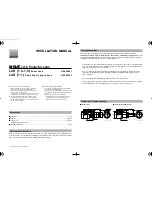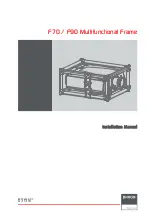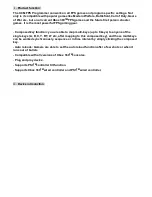
50
Section 4: Operating Instructions
RCF3696, RCFM3696, RCF3610, & RCFM3610 Rotary Cutters 326-600M
8/20/21
Transporting
WARNING
!
To avoid serious injury or death:
•
When traveling on public roads, use LED lights, slow
moving vehicle sign, clean reflectors, and other adequate
devices to warn operators in other vehicles of your
presence. If implement blocks visibility of slow moving
vehicle sign, relocate sign so it is visible from the back at all
times. Always comply with all federal, state, and local laws.
•
Select a safe ground speed that will allow adequate control
of steering and stopping. Never exceed 20 mph (32.2 km/h)
with attached equipment. Rough terrain requires a slower
•
Reduce ground speed when turning and leave enough
clearance to avoid making contact with obstacles such as
buildings, trees, fences, etc.
•
Always disengage power take-off and wait for the driveline
to stop rotating before raising the implement to the
1. Make sure driveline does not contact tractor or cutter
when raising cutter to the transport position.
2. Reduce tractor ground speed when turning and leave
enough turning clearance so cutter does not contact
obstacles such as buildings, trees or fences.
3. Limit transport speed to 20 mph. Transport only with
a farm tractor of sufficient size and horsepower.
4. When traveling on roadways, transport in such a way
that faster moving vehicles may pass you safely.
5. Shift tractor to a lower gear when traveling over rough
or hilly terrain.
Blade Engagement & Disengagement
Cutter blades can lock-up against each other during
start-up and shut-down especially if the tractor’s power
take-off engagement is
“INSTANT ON”
and
“INSTANT
OFF”
. Following Blade Engagement and Blade
Disengagement instructions below will help eliminate
blade lock up.
Blade Engagement
1. Increase throttle speed just enough to get the blades
rotating without stalling tractor while slowly engaging
power take-off. Use tractor’s power take-off soft start
option if available.
2. Ensure that all power shafts are rotating and that the
cutter is not vibrating excessively after ramping up to
power take-off speed for at least 3 seconds. If
excessive vibration continues after 3 seconds at full
power take-off speed, disengage power take-off
immediately, shut down tractor, remove switch key,
and wait for blades to come to a complete stop.
3. Check blades for a lock-up situation. Block cutter
deck up before working under the unit. Unlock
blades, remove support blocks, and repeat
Blade Disengagement
1. Slowly decrease throttle speed until engine idle
speed is reached and then disengage power take-off.
2. Engage tractor park brake, shut tractor engine off
and remove switch key. Stay on tractor until blades
have come to a complete stop.
Field Operation
DANGER
!
To avoid serious injury or death:
Clear area to be cut of debris and other unforeseen removable
objects before cutting. Mark non-removable hazards such as
tree stumps, post stubs, protruding objects, rocks, drop-offs,
holes, etc. with a visible flag.
WARNING
!
To avoid serious injury or death:
Do not back pull-type cutter into solid objects. The joint where
the tongue is pinned to the deck will pivot upward causing
damage to the deck and driveline.
1. Thoroughly inspect area to be cut for debris and
unforeseen objects. Mark any potential hazards.
instructions on this
page to start cutter blades turning.
3. Optimum ground speed depends on density of
material, horsepower, and terrain. Always operate
tractor at cutter’s full-rated power take-off speed in a
gear range (2 to 5 mph) that allows the cutter to make
smooth cuts without lugging the tractor down.
4. Stop traveling and disengage power take-off after the
first 50 feet of cutting. Check cutter levelness and
cutting height to make certain it is adjusted properly.
IMPORTANT:
Maintain correct power take-off speed. Loss of power
take-off speed will allow blades to swing back
resulting in ragged, uneven cutting.
Your cutter is equipped with free swinging cutting
blades to reduce shock loads when striking
obstacles. However, it is best to avoid striking
obstacles to extend cutter and blade life.
NOTE:
Do not cut in wet conditions. Wet material
will build up on the deck underside creating poor
discharge, high wear, and additional horsepower
consumption.
Periodically disengage power take-off, turn off
tractor, remove key and check for objects wrapped
around blade spindle. Block deck up before removing
objects.
Frequently inspect cutter for loose bolts and nuts.
Tighten all loose hardware as indicated in the
“Torque Values Chart”
on page 70.
















































